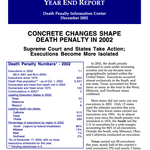The Death Penalty in 2002: Year End Report
Posted on Dec 17, 2002

Summary Top
In 2002, the death penalty continued to come under increasing scrutiny and its use became more geographically isolated within the United States. Executions occurred almost exclusively in the South, and one state, Texas, accounted for three times as many as the total in the West, Midwest, and Northeast states combined.
Most states did not carry out any executions in 2002. Only 13 states used the ultimate sanction this year. The last time fewer states carried out executions was 1993. As in almost every year since the death penalty was reinstated in 1976, the South led the U.S. in executions by a wide margin, accounting for 86% of all executions. Outside the South, only Missouri, Ohio, and California conducted an execution.
Texas carried out 33 executions this year, nearly half of the country’s total executions (71) and nearly 5 times as many as Oklahoma, the next leading state with 7. For the second straight year, Texas was the only state to execute juvenile offenders. Despite international protests, the state executed 3 inmates who were under 18 at the time of their offense, all of whom were black. Of the 21 juvenile offenders executed in the U.S. since the death penalty was reinstated, 13 (62%) have been in Texas.
There were other indications of the declining use and increasing skepticism about the death penalty: new death sentences and executions remained at a lower level compared to the late 1990s, and the size of death row declined after years of increases. Public opinion (see separate section below) remained divided on whether the death penalty or a sentence of life without parole was the most appropriate sentence for first degree murder. Support for the death penalty is lower than the support registered in the early 1990s, despite the terrorist attacks of September 11, 2001 and the recent sniper shootings in the Washington, DC area.